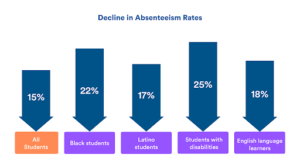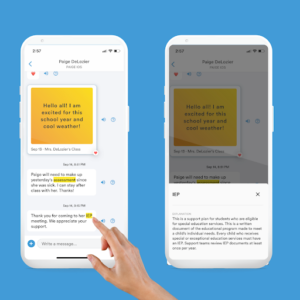by Heather Dooley
Practical ways to tap into your greatest (and free!) resource to improve attendance: families
Chronic absenteeism has long been a critical concern for schools and districts, and with good reason: when students miss school, they miss out on learning and face increased risks of poverty, poor health and well-being, and involvement in the criminal justice system. Systems suffer, too – based on the funding formulas used, enrollment and attendance can significantly impact budgets, which affects the programming and resources schools and districts can provide. For example, in a district with 20,000 students, 18 missed days per student could equal a loss of $100,000 per day or $20 million per year in lost revenues.
And, as with many things, the pandemic exacerbated attendance challenges, particularly for historically underserved students. Chronic absence levels are estimated to have doubled between the 2018-19 and 2021-22 school years (from 8 million to 16 million students) and now affect one out of every three students.
The good news is that every district and school has a powerful, free resource they can tap into – one that research shows can make a big difference in improving attendance: families.
Here are five ways leaders can harness the power of families to address barriers that keep students from coming to school. To learn more, check out our recent webinar How to Use Family Engagement to Improve Attendance and Enrollment Outcomes, where we walk through easy-to-implement strategies districts and schools can use today.
1) Meet families where they are
Families are busy. Many don’t use e-mail or may not have ready access to a computer or wifi. Others may be uncomfortable with phone calls and voicemails, particularly those less fluent in English, and many may be unable to pick up the phone during work hours. Streamline communication by using text messages as the primary means of communication. Since nearly all families have a mobile phone, texting uses a ubiquitous channel, and one most families prefer. Texting works with family schedules, has no barrier to participation, and is more likely to be noticed and elicit a response. For families, getting started is as simple as receiving a text from their child’s teacher or school in their home language and responding, with no wifi, downloads, or sign-ups required.

2) Message families in their preferred language
One of the best ways to welcome families and foster an inclusive, supportive culture is to address families in their home language. With this in mind, TalkingPoints has invested deeply in providing real-time, two-way texting using the highest-quality translation for PK-12 education in 150 languages.
For families that need more support, teachers or staff can send a text to invite them to download the free, optional, TalkingPoints for Families mobile app or sign in online. They’ll be able to access features that expand equity and access, including:
- Speech-to-text
- Text-to-speech
- An “Ed 101” tool that explains unfamiliar education terms
- “Help Me Understand” on-demand human translation when needed to clarify a message
These features help families with limited literacy, unfamiliar with the US education system, or with other barriers communicate more easily with teachers and school staff.
3) Make it easier for families to report absences
Remove barriers to reporting absences for families by using the platform they’re already comfortable using to communicate with their child’s teacher. Many families are intimidated by the idea of calling their child’s school and are uncomfortable leaving a message, especially those with limited or no English. Having to navigate different systems within a school can also be overwhelming. Instead of asking families to call an attendance line, let them send a quick text, in their home language, to the attendance number for the school in the same way they text their child’s teacher. This approach can streamline work for staff, too. Administrators can upload a group of daily absent students and communicate quickly with one message sent as an instantly-translated text to each family. Because families are already used to communicating this way with their child’s teachers, they’ll be better able to understand the message and more likely to engage.

“I am a counselor at Hebron High School. There have been times when a student is not attending school due to mental health concerns, and I have been able to connect with their parent to see how I can support the family. This is especially helpful since the student wasn’t attending school (which means I cannot support the student directly on campus) but TalkingPoints allows for me to still provide support and resources to the family. The parent was able to feel like their student mattered and the school cares about the family.”
– Stephanie Banuelos, Hebron High School, TX
4) Address root causes
By making it easy for families to share why their child missed school and establishing trusted relationships through regular check-ins with families, educators will be better equipped to understand root causes and help align resources to address them.
New post-pandemic challenges
The pandemic exacerbated conditions that contribute to chronic absence, such as student anxiety, unstable housing, poor sleep, lack of transportation, or environmental issues like bullying that keep kids from coming to school.
“As the nation struggles to find amazing bus drivers, our students are the ones who suffer the most. With no other form of transportation, a mom reached out, indicating the bus had not shown up. Because of this app, she was able to quickly and easily message me in her native language. We were able to communicate this information to the bus company and quickly have a bus come to pick up her child. Without this app, my student would have missed school because of a simple scheduling error that is no one’s fault. This app has given me the opportunity to connect with families on a new level.”
– Spencer Higgins, teacher, Pine Grove School, MA
Teachers have shared that they’re finding that students face a lack of stamina for full-day, in-person learning post-pandemic.
Experts note that the pandemic may have fundamentally shifted attitudes about school that will take some time and intention to rebuild. For example, one school analyzed their attendance data and found a trend of pronounced absenteeism on Mondays, a day many of the school’s parents who work in service industries have off use as time to spend with their kids.
“The pandemic really, really, broke down connections and relationships between kids and schools.”
– Hedy Chang, CEO of Attendance Works.
Communicate early and often
Sometimes, parents don’t understand how quickly absences can become chronic and how damaging they can be to student life and learning outcomes. And it adds up: a student who misses 18 days of school per year will have lost an entire year’s worth of learning by the time they reach 12th grade.
School leaders should reach out early – before school even starts – to learn from families about their needs and explain why attending school matters so much for their child’s learning and well-being. Early, intentional family engagement can go a long way toward fostering a positive, school-going culture. Research shows:
- Absenteeism in the first month of school can predict poor yearly attendance.
- Attendance rates are better in schools where parents feel welcomed and engaged and where they trust their children are safe.
- A recent quasi-experimental study meeting the ESSA Tier 2 standard of evidence showed using TalkingPoints to engage families decreased absenteeism by 15% in a large, diverse district, with even better outcomes among traditionally underserved student groups.

5) Share positive, proactive behavior updates
The start of the year is a great time to welcome families and lay the groundwork for productive relationships between home and school.
The name “TalkingPoints” came from the fact that when teachers share positive information home to families about what their student learned that day, it spurs better conversations at home (because the family has specific “talking points” from the teacher to discuss with their child). The exchanges often make students feel proud, motivated, and excited to attend school.
Encourage teachers to reach out in the first month of school to welcome the family. Teachers can introduce themselves, learn more about each student’s interests and struggles, and send home at least one positive behavior update.
“I use TalkingPoints to communicate with my families on a daily basis. It has helped increase my student’s attendance and allows my parents to engage in their student’s learning.”
– Michael Mulloy, Arvada High School, CO
By communicating consistently and starting with a positive tone with families, educators can lay the foundation for trusting relationships. Then, if there is a behavior or attendance issue to address, the family is more likely to be receptive, and you can de-escalate issues before they become serious.
To learn more, check out our recent webinar How to Use Family Engagement to Improve Attendance and Enrollment Outcomes, where we walk through easy-to-implement strategies districts and schools can use today.
About TalkingPoints
TalkingPoints is an education technology nonprofit that drives student success by removing critical barriers to equitable family-school partnerships, such as language, time, mindsets, and capacity. Ten of the country’s twenty largest school districts trust TalkingPoints to create a district culture where all families, no matter their background, can engage with their schools. Our simple, intuitive family engagement platform offers the highest-quality human- and AI-powered two-way translated communication in 150 languages and counting. Named by Common Sense Education as “the best overall family communication platform for teachers and schools,” TalkingPoints leads to higher test scores and lower absenteeism, as shown by rigorous causal research that meets the ESSA Tier 2 standard of evidence. To learn more, view our TED Talk or visit talkingpts.org.




